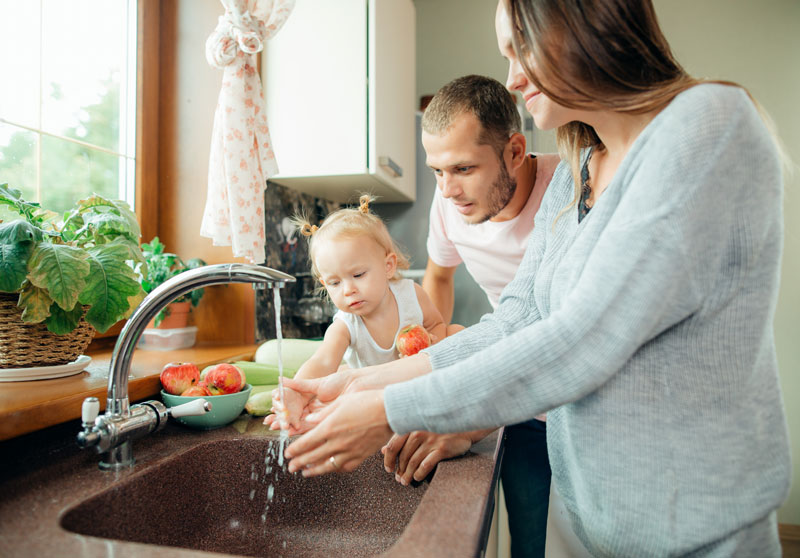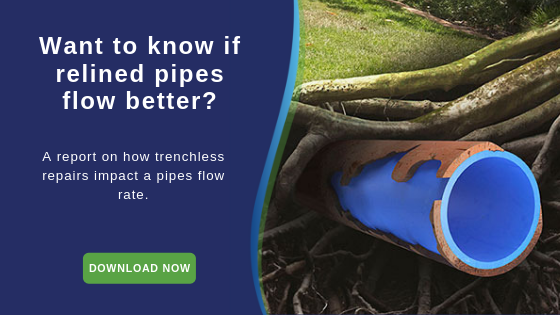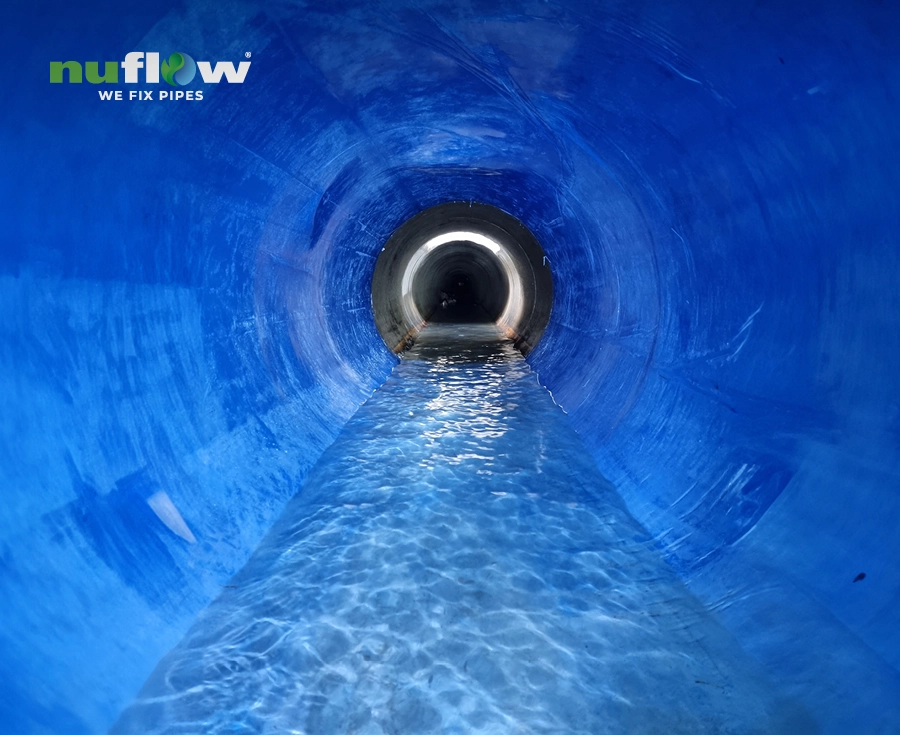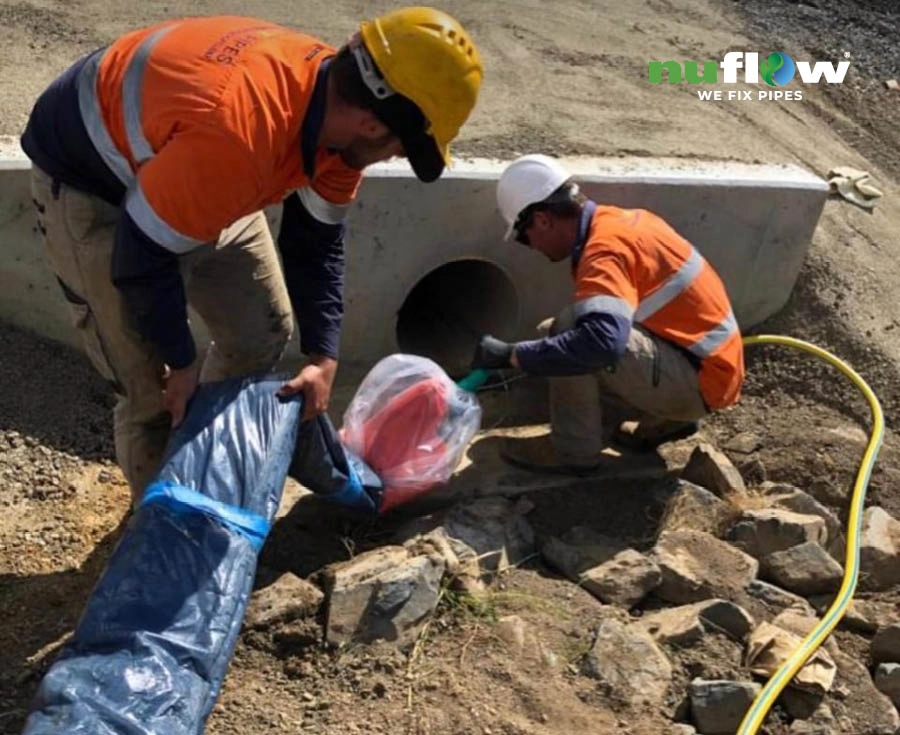If the kitchen is the heart of the home, then the drains and pipes that bring us fresh, clean water and take away liquid waste, are just as surely the vital arteries and veins that keep things pumping.
And as with our own body’s fluid transport system, what gets into those ‘pipes’ really does matter.
Just like blockages in our bodies, clogged, blocked or damaged pipes and drains in the kitchen can spell disaster for the overall functioning of the home.
Holiday rentals, commercial kitchens and workplace cafeterias often come complete with shiny, laminated sets of rules displayed near the sink for everyone to see. These rules are designed to keep areas safe, clean and in good working order for as long as possible. But when it comes to keeping things operating efficiently around the kitchen sink at home, it can sometimes be the absence of ‘rules’ and the bad habits we or our family/housemates have developed over time that bring us unstuck.
We’ve consulted our in-house plumbers and talked to a range of external experts to create some ‘rules’ that will help maintain the health of your kitchen pipes and drains.
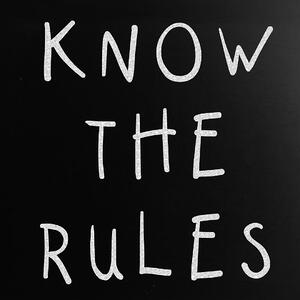
Be creative and write them on a chalkboard, paint and decorate your own ‘shabby-chic boho-styled’ kitchen rules board for a wall near the sink, or if your housemates aren’t great at subtle hints, make your own shiny laminated sign and stick it somewhere they just can’t miss.
Whatever way you choose to get your message across, making sure everyone in your household takes care with what goes down the drain and into your pipes can save a whole lot of inconvenience later on and the expense of calling a plumber.
THE FIVE BASIC RULES FOR KEEPING YOUR KITCHEN SINKS AND DRAINS TROUBLE FREE
We asked dozens of qualified plumbers for their opinions on the leading causes of clogged or blocked kitchen drains. The top five responses were:
- food being rinsed down the drain
- congealed fats and oils going down the drain
- food scraps/fats going into dishwashers then down the kitchen waste pipes
- home owners not cleaning their dishwasher regularly
- coffee grounds being rinsed down the drain
Based on these responses, we’ve not only created a set of kitchen rules designed to keep your sink blockage-free and functioning beautifully, we’ve done the research to find out just why these practices are so damaging for kitchen drains and pipes.
KITCHEN RULE NO. 1: DON’T LET ANY FOOD LARGER THAN CRUMBS DOWN THE DRAIN
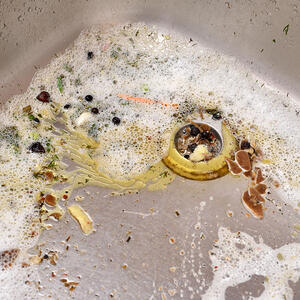
Some foods take a very long time to break down, and if they get caught in a particular area of the sink’s drainage system, they cause an obstruction that can then block other particles. The particles build up over time, and whilst it may take a few years, they will eventually form somewhat of a dam and reduce or completely stop the flow.
There are also foods that actually expand when they are left to sit in moisture (rice, pasta, diced vegetables, tea leaves etc.), so they can end up much larger in your drain than they were on your plate.
When food scraps get stuck in your drain, not only can they lead to a later blockage, they also grow bacteria and mould as they break down, producing a foul smell.
Use a sink waste strainer at all times and make the effort to empty it regularly. It may not be one of the most pleasant jobs, but neither is it the worst so don’t be tempted to be lazy and let food scraps disappear into the abyss because you’ll often pay the price big time later.
Apart from the increased risk of blockage, there’s the smell from the drain – so scrape plates into the garbage before rinsing them and use the sink strainer.
KITCHEN RULE NO. 2 – NEVER PUT FATS OR OILS DOWN THE DRAIN
‘Why? They’re liquids; they should slip down the drain easily!’ I hear you ask.
There are actually two very good reasons for not putting oils down the drain.
1. They solidify
Water and oil don’t mix, and as most cooking oils cool, they solidify. Drains and pipes are dark and cold; sometimes freezing. The mix of fats and oils that are involved with cooking (animal fats, butter, creams and cooking oil) are attracted to each other and once in the sink pipes will join together, adhere to the walls of the pipe (particularly around lips, bends or areas of corrosion) and when cooled, form quite solid lumps. These lumps can become rock hard and will trap other food particles that have snuck down the sink, thus creating a dam that can block your waste water pipes completely.
2. They create ‘fatbergs’ and can lead to sewage backups
When cooking oil is washed down the kitchen sink it travels through your pipes to the local sewer, where it mixes with other waste water, chemicals and substances, including calcium. The oils and fats break down into their component parts of glycerol and fatty acids, which bind with the calcium to create a compound with a soapy consistency. This ‘soap’ remains in the sewer system and when water levels rise (such as overflow during storms or heavy rains) the fatty blobs cling to the ceilings and sides of the pipes, building up and becoming waxy fatbergs.
Fatbergs (yes, it’s a real term) are very large masses of solid waste found in sewerage systems. They consist of congealed fat and personal hygiene products that have been flushed down toilets. Unbelievably, some people flush things down the toilets which are not biodegradable (such as nappies, cosmetic and baby wipes, condoms, dental floss, cotton swabs and sanitary pads) and which, when combined with the oils and fats, pose a significant threat to the environment and the efficiency of local sewage treatment infrastructure. They can block sewer lines and cause sewage backups that can release pathogens and bacteria into fresh water systems and soils and eventually impact human health. These fatberg masses can also block water treatment processes, further damaging supply in general.
HOW TO DISPOSE OF FATS AND OILS RESPONSIBLY
Again, it may take a bit more effort but it is essential for your pipe, human and environment health that you dispose of cooking oil responsibly.
You have a few options here from which to choose.
Recycle them
a. With an oil recycling company
For larger quantities, such as those generated by commercial kitchens, there are companies that will collect used cooking oil and recycle it into things such as bio-fuels, cosmetics and stock feed. Some of these companies don’t even charge for their services and will supply you with special vessels to collect the oil. There are a couple of Australasian companies that have been doing it for years, so just do your homework to ensure they are reputable and are disposing of the oils responsibly.
b. Yourself
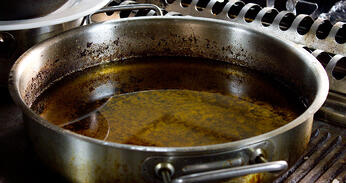
Remarkably, until the 1970s that fat left in the pan was commonly collected and stored in the fridge to be used as a spread for bread (ask your grandparents about eating bread and dripping for dinner during the Great Depression). The practice became unpopular in the 70s, when it was thought that the fat contributed to heart disease and obesity, but today the jury is still out in terms of whether it is any worse than butter.
You can even re-use cooking oil without any problems, as long as it hasn’t smoked (become really hot and started emitting smoked trails) and if you haven’t used it to cook seafood.
Simply strain the oil through a coffee filter paper to trap any solids then store it in the refrigerator. It will cool to become solid (so you can see what it would have looked like once it cooled in your drainage pipes) and you add to it whenever you use fresh oil.
c. At a local tip
It is also possible that a council recycling centre in your area might accept cooking fats and oils as part of their recycling program.
Throw them out
If the concept of re-using oil just isn’t your thing, then disposing of them with the garbage is fine.
Oils that solidify should be poured into an empty can or jar (when still liquefied but not hot) and thrown out when solid.
For oils that don’t solidify, simply pour them into a sealable (hopefully non-recyclable) bottle, and throw the whole container away with your regular garbage.
KITCHEN RULE NO 3 SCRAPE AND RINSE ITEMS GOING INTO THE DISHWASHER
Your dishwasher waste goes straight to the same pipe as your sink waste, so making sure grease and food doesn’t enter the pipe and cause those same build-ups and blockages is just as important here.
Ensure scraps left or dried on plates and utensils are either scraped into the bin or rinsed off using warm water and a sink strainer. When you’re rinsing very greasy plates prior to putting them into the dishwasher (or even prior to hand washing) make sure you are adding some detergent to the mix and using hot water. This will break up the grease and prevent the fatty water from sitting in the trap bend under the kitchen sink (the P-trap).
KITCHEN RULE NO. 4 – CLEAN YOUR DISHWASHER ONCE A MONTH
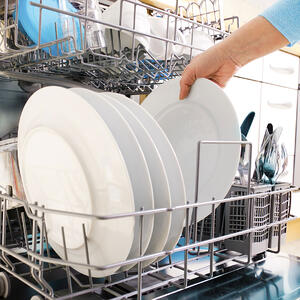
Unless you’re feeling you’d like to return to the ‘dark ages’ of hand washing every cup, plate and utensil, the waste water drainage pipes in your dishwasher need to be looked after too. These pipes can become blocked because of a build-up of food particles and fat, similar to the blockages that can occur in your sink pipes.
To prevent a build-up in the dishwasher waste hose, clean it every month, either with a commercial cleaner or with a natural alternative like bi-carb soda. You can read more about this in our third article in the series which provides tips and tricks for clearing blockages in drains.
KITCHEN RULE NO. 5 NEVER POUR COFFEE GROUNDS INTO YOUR SINK
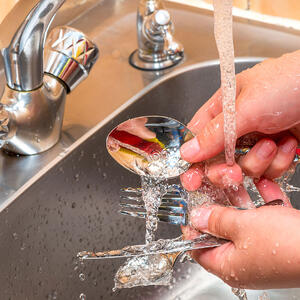
Coffee granules don’t break down in water. The grounds will actually expand in water and will clump together to clog your pipes. And why would you want to throw those precious little grounds away anyway. Coffee grounds actually have a very impressive list of potential uses, from eliminating odours to killing fleas on your dog to making a great beauty scrub. Read this article for a great list of ways to use coffee grounds.
Knowing exactly what happens in your kitchen pipes when you break one of these rules is a great incentive for doing the right thing, and it’s important everyone in your household understands that out of sight SHOULDN’T be out of mind when it comes to what goes down the drain in your kitchen.
Let them read this article, or at the very least, explain to them why your rules are important, not only for the health of your own kitchen drains and pipes but for the environment and wider community as well.
If you think a daily reminder will help, simply find a creative way of having these five basic rules for maintaining healthy drainage pipes posted somewhere near the sink. They’ll most likely only need to be there for a few months until everyone gets the message, but the benefits of the lesson will last a lifetime.
If you’re worried you may already have done some damage, check out the other articles in this series, Common signs of clogged kitchen pipes – a list of signs that can help you identify when you might have pipe problems in your kitchen and Clearing blockages in clogged kitchen sinks and drains, which includes some simple tips and tricks you can use to clear minor blockages before they turn into something so big only the plumber can handle it.
If you’d like more technical information on relining, call a Nuflow technician on 1800 335 766 (Australia) or 0800 168356 (New Zealand) or visit our contact page to find your local Nuflow.

